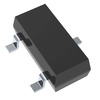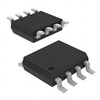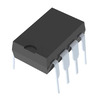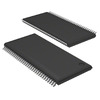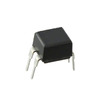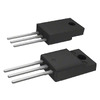CC1101 Transceiver: Datasheet, Pinout, and Alternatives
The CC1101 from Texas Instruments is a versatile sub-1 GHz transceiver that provides a cost-effective solution for power-conscious wireless applications. This article explores its technical features, pinout, and specifications, highlighting how it supports the growing demand for efficient and reliable wireless communication systems.Catalog

What is the CC1101?
The Texas Instruments CC1101 stands out as a cost-effective transceiver crafted specifically for wireless communications in the sub-1 GHz range. Its design focuses on minimizing energy consumption, resonating well within the ISM and SRD bands at frequencies like 315, 433, 868, and 915 MHz. Moreover, it showcases adaptability by incorporating additional bands such as 300-348 MHz, 387-464 MHz, and 779-928 MHz, rendering itself versatile across varied territorial and regulatory landscapes. Within its architecture lies a flexible baseband modem, adept at accommodating different modulation formats and achieving data rates up to 600 kbps. This versatility finds value in applications where data transmission requirements fluctuate.
The CC1101 is employed alongside a microcontroller, accompanied by some passive components, highlighting an industry-favored method that capitalizes on modular design beneficially to amplify systemic performance. In situations demanding extended communication reach, pairing with a CC1190 range extender is common. This synergy not only heightens the device's sensitivity but also boosts its output power, enhancing network robustness and reliability. The CC1101's features reveals its promising role in IoT device management, smart metering, and remote control applications where efficiency, coupled with modulation flexibility. Its inherent modularity and adaptability embody a scalable solution adept at keeping pace with technology's ever-shifting landscape, suggesting it holds promise for ongoing advancements in wireless communications.
CC1101 Pin Configuration

|
Pin No |
Pin Name |
Description |
|
1 |
SCLK |
Serial configuration interface, clock input |
|
2 |
SO (GDO1) |
Serial configuration interface, data output. Optional
general output pin when CSn is high |
|
3 |
GDO2 |
Digital output pin for general use: Test signals, FIFO
status signals, Clear channel indicator, Clock output, down-divided from
XOSC, Serial output RX data |
|
4 |
DVDD |
1.8 - 3.6 V digital power supply for digital I/O’s and
for the digital core voltage regulator |
|
5 |
DCOUPL |
1.6 - 2.0 V digital power supply output for decoupling.
NOTE: This pin is intended for use with the CC1101 only. It cannot be used to
provide supply voltage to other devices |
|
6 |
GDO0 (ATEST) |
Digital output pin for general use: Test signals, FIFO
status signals, Clear channel indicator, Clock output, down-divided from
XOSC, Serial output RX data, Serial input TX data. Also used as analog test
I/O for prototype/production testing |
|
7 |
CSn |
Serial configuration interface, chip select |
|
8 |
XOSC_Q1 |
Crystal oscillator pin 1, or external clock input |
|
9 |
AVDD |
1.8 - 3.6 V analog power supply connection |
|
10 |
XOSC_Q2 |
Crystal oscillator pin 2 |
|
11 |
AVDD |
1.8 - 3.6 V analog power supply connection |
|
12 |
RF_P |
Positive RF input signal to LNA in receive mode. Positive
RF output signal from PA in transmit mode |
|
13 |
RF_N |
Negative RF input signal to LNA in receive mode. Negative
RF output signal from PA in transmit mode |
|
14 |
AVDD |
1.8 - 3.6 V analog power supply connection |
|
15 |
AVDD |
1.8 - 3.6 V analog power supply connection |
|
16 |
GND |
Analog ground connection |
|
17 |
RBIAS |
External bias resistor for reference current |
|
18 |
DGUARD |
Power supply connection for digital noise isolation |
|
19 |
GND |
Ground connection for digital noise isolation |
|
20 |
SI |
Serial configuration interface, data input |
CC1101 Symbol, Footprint, and CAD Model



Features of the CC1101
RF Performance
The CC1101 module combines high sensitivity with power efficiency, offering up to +12 dBm of programmable output power while consuming minimal energy. This makes it ideal for energy-conscious devices, especially in IoT systems where long battery life is important. By balancing sensitivity and energy use, the module enhances communication range and device durability.
Analog Features
The CC1101 supports multiple modulation techniques, quick frequency tuning, and includes an integrated temperature sensor. These features provide flexibility and reliability in varying environments, making it easy to adapt communication strategies for specific needs. Temperature compensation and dynamic modulation options boost performance in challenging conditions.
Digital Features
The CC1101 includes advanced digital tools like packet handling, a flexible SPI interface, wireless detection, and data whitening. These ensure secure and efficient data transmission, improving system stability and speed. Its optimized packet management enhances performance in complex digital systems, making it ideal for reliable wireless communication.
Power Efficiency
The CC1101 is highly power-efficient, drawing only 200 nA in sleep mode and featuring fast startup and wake-on-radio capabilities. This low power consumption extends battery life, reducing the need for frequent replacements, which is important for devices like remote sensors and electronics.
General Characteristics
With a compact design and minimal external components, the CC1101 meets both European and US standards. Its small size and regulatory compliance make it versatile for global markets. Simplifying designs while maintaining robustness aligns with modern industrial practices, ensuring easy integration across various applications.
CC1101 Technical Specifications
Technical specifications, features, and parameters of the CC1101, along with components similar to the Texas Instruments CC1101RGP.
|
Type |
Parameter |
|
Lifecycle Status |
ACTIVE (Last Updated: 4 days ago) |
|
Contact Plating |
Gold |
|
Mounting Type |
Surface Mount |
|
Number of Pins |
20 |
|
Operating Temperature |
-40°C~85°C |
|
JESD-609 Code |
e4 |
|
Part Status |
Active |
|
Number of Terminations |
20 |
|
Voltage - Supply |
1.8V~3.6V |
|
Peak Reflow Temperature (Cel) |
280 |
|
Supply Voltage |
3V |
|
Depth |
4.15mm |
|
Base Part Number |
CC1101 |
|
Power - Output |
12dBm |
|
Data Rate (Max) |
800kbps |
|
Factory Lead Time |
6 Weeks |
|
Mount |
Surface Mount |
|
Package / Case |
20-VQFN Exposed Pad |
|
Weight |
69.994479mg |
|
Packaging |
Tube |
|
Pbfree Code |
Yes |
|
Moisture Sensitivity Level (MSL) |
3 (168 Hours) |
|
Type |
Tx/Rx Only |
|
Terminal Position |
QUAD |
|
Number of Functions |
1 |
|
Terminal Pitch |
0.5mm |
|
Frequency |
300MHz348MHz, 387MHz464MHz, 779MHz~928MHz |
|
Density |
0 b |
|
RF Family/Standard |
General ISM < 1GHz |
|
Serial Interfaces |
SPI |
|
Current - Receiving |
14.3mA~17.1mA |
|
Current - Transmitting |
12.3mA~34.2mA |
|
Number of Receivers |
1 |
|
Modulation |
2FSK, 4FSK, ASK, GFSK, MSK, OOK |
|
Sensitivity (dBm) |
-116 dBm |
|
Length |
4mm |
|
Thickness |
930µm |
|
Height |
1mm |
|
Width |
4mm |
|
Radiation Hardening |
No |
|
Lead Free |
Lead Free |
|
REACH SVHC |
No SVHC |
|
RoHS Status |
ROHS3 Compliant |
Functional Block Diagram of the CC1101

The diagram above shows the CC1101 basic structure, which uses a low-IF receiver design. First, the low-noise amplifier (LNA) strengthens the RF signal. This signal is then converted into intermediate frequency (IF) signals in two components (I and Q). These signals are digitized using analog-to-digital converters (ADCs). After digitization, processes like automatic gain control (AGC), channel filtering, demodulation, and synchronization of bits and packets are performed. For transmitting, the CC1101 generates RF signals directly using frequency synthesis.
In receive mode, the chip’s frequency synthesizer uses an on-chip LC VCO and a 90-degree phase shifter to create the local oscillator (LO) signals (I and Q) needed for signal conversion. A crystal connected to pins XOSC Q1 and XOSC Q2 provides the reference frequency for the synthesizer and clocks for the ADC and digital circuits. A 4-wire SPI interface is used for configuration and data access, while the digital baseband manages channel settings, packet handling, and data storage.
CC1101 Application Circuit

Typical Application and Evaluation Circuit 315/433 MHz (excluding supply decoupling capacitors)

Typical Application and Evaluation Circuit 868/915 MHz (excluding supply decoupling capacitors)
Alternatives to the CC1101
|
Part Number |
Description |
Manufacturer |
|
CC1100ERGPT |
Low-power Sub-1GHz wireless transceiver for China and
Japan frequency bands 20-QFN -40 to 85 |
Texas Instruments |
|
MD59-0049RTR |
RF and Baseband Circuit, PQCC20, 4 MM, PLASTIC, MLF-20 |
MACOM |
|
CC1101RTKRG3 |
IC TELECOM, CELLULAR, RF AND BASEBAND CIRCUIT, PQCC20, 4
X 4 MM, GREEN, PLASTIC, QLP-20, Cellular Telephone Circuit |
Texas Instruments |
|
CC1101RTK |
TELECOM, CELLULAR, RF AND BASEBAND CIRCUIT, PQCC20, 4 X 4
MM, GREEN, PLASTIC, QLP-20 |
Texas Instruments |
|
CC1101RTKG3 |
TELECOM, CELLULAR, RF AND BASEBAND CIRCUIT, PQCC20, 4 X 4
MM, GREEN, PLASTIC, QLP-20 |
Texas Instruments |
|
CC1101RGP |
Package / Case 20-VFQFN Exposed Pad, Number of Pins 20,
Frequency 300MHz ~ 348MHz, 387MHz ~ 464MHz, 779MHz ~ 928MHz, Current -
Receiving 14.3mA ~ 17.1mA, Current - Transmitting 12.3mA ~ 34.2mA,
Sensitivity -116 dBm, Supply Voltage 3 V, Terminal Pitch 0.5 mm |
Texas Instruments |
|
CC115LRGPR |
Package / Case 20-VFQFN Exposed Pad, Number of Pins 20,
Frequency 300MHz ~ 348MHz, 387MHz ~ 464MHz, 779MHz ~ 928MHz, Current -
Receiving 13.9mA ~ 15.9mA, Current - Transmitting 12.3mA ~ 31.1mA,
Sensitivity -112 dBm, Supply Voltage 3 V, Terminal Pitch 0.5 mm |
Texas Instruments |
|
CC1100RTKR |
Package / Case 20-VFQFN Exposed Pad, Number of Pins 20,
Frequency 300MHz ~ 348MHz, 387MHz ~ 464MHz, 779MHz ~ 928MHz, Current -
Receiving 13.3mA ~ 15.9mA, Current - Transmitting 12.3mA ~ 34.2mA,
Sensitivity -111 dBm, Supply Voltage 3 V, Terminal Pitch 0.5 mm |
Texas Instruments |
|
CC110LRGPR |
Package / Case 20-VFQFN Exposed Pad, Number of Pins 20,
Frequency 315MHz, 433MHz, 868MHz, 915MHz, Supply Voltage 3 V, Terminal Pitch
0.5 mm |
Texas Instruments |
|
CC1100RTK |
Package / Case 20-VFQFN Exposed Pad, Number of Pins 20,
Frequency 300MHz ~ 348MHz, 387MHz ~ 464MHz, 779MHz ~ 928MHz, Current -
Receiving 14.3mA ~ 17.1mA, Current - Transmitting 12.3mA ~ 34.2mA,
Sensitivity -116 dBm, Supply Voltage 3 V, Terminal Pitch 0.5 mm |
Texas Instruments |
Applications of the CC1101
The CC1101 is an ultra-low-power wireless transceiver designed for sub-1 GHz applications, ideal for scenarios where energy-efficient communication is required. Its versatility makes it valuable in security systems, automation, industrial operations, and emerging technologies like IoT.
Security Systems
The CC1101 enhances wireless security systems by enabling low-power, long-lasting devices like motion detectors and alarm sensors. Its efficiency reduces the need for frequent maintenance, ensuring uninterrupted monitoring and extended battery life.
Automation Solutions
In both home and industrial automation, the CC1101 supports seamless communication between devices, enabling smart systems to monitor environmental metrics and optimize energy use. It’s a key component in building more efficient and adaptive living and working environments.
Industrial Processes
The CC1101 facilitates reliable wireless communication in challenging industrial settings, allowing remote monitoring and control of machinery. This improves safety, reduces downtime, and enhances operational efficiency, especially where wired solutions are impractical.
Emerging Technologies and IoT
The CC1101's flexibility makes it a strong candidate for Internet of Things (IoT) applications, supporting low-power, wide-area networks. As IoT expands, the CC1101 is great in creating smart, energy-efficient devices that communicate seamlessly across interconnected systems.
Package for CC1101

CC1101 Manufacturer Information
In the competitive landscape of the semiconductor industry, Texas Instruments stands distinguished for its influence on analog and embedded processing innovations. The company's CC1101 RF transceiver exemplifies their relentless drive toward refining communication technologies. This device is not only crafted with precision but also finds its utility across diverse sectors, including home and industrial automation where stable and efficient wireless systems. Texas Instruments thrives on an unwavering dedication to pioneering new technologies and developing products that resonate with current industry trends. Their philosophy is driven by the aspiration to merge state-of-the-art technology with practical uses. TI products are crafted through repetitive improvements to ensure they seamlessly integrate with various systems, showcasing an adaptability that meets diverse requirements.
Datasheet PDF
CC1100ERGPT Datasheets:
Cylindrical Battery Holders.pdf
CC1100ERGPT Datasheets:
Cylindrical Battery Holders.pdf
CC1101RTK Datasheets:
CC115LRGPR Datasheets:
CC1100RTKR Datasheets:
CC110LRGPR Datasheets:
CC110LRGPR Datasheets:
About us
ALLELCO LIMITED
Read more
Quick inquiry
Please send an inquiry, we will respond immediately.
Frequently Asked Questions [FAQ]
1. What makes CC1101 more friendly than SI4432 in terms of setup?
Setting up the CC1101 radio module is notably more straightforward compared to alternatives such as the SI4432. Its design incorporates fewer configuration registers, along with robust support from Texas Instruments' SmartRF Studio, enhancing its appeal.
2. How can one enhance CC1101's ability to resist interference?
Boosting CC1101's interference resistance involves implementing several strategic measures. To start, ensure power supply isolation by employing effective shielding methods. Extending preambles enhances data synchronization, even amidst interference. Further, defining precise sync words improves data integrity. Both hardware and software enhancements play roles in bolstering communication reliability.
3. In what ways does the CC1101 chip differ from the CC1101-Q1 variant?
The defining difference between the CC1101 and its automotive-grade variant, the CC1101-Q1, lies in the latter’s enhanced operational temperature range, suited for the rigors of automotive applications. Despite this adaptation, both versions maintain consistent performance standards, ensuring the core functionalities remain intact. This attribute proves beneficial in automotive settings where environmental variables can fluctuate.
4. Why integrate an Arduino Uno (ATMEGA328P) with a CC1101 on a breadboard, and what are Arduinos used for?
Combining Arduino Uno with the CC1101 on a breadboard provides a versatile platform into electronics. Arduino’s open-source framework enables seamless translation of inputs to outputs, catering to a broad range of projects. Breadboarding facilitates flexible experimentation and prototyping. Recognizing community-driven innovation, these setups often lay the groundwork for exploratory learning, allowing individuals to engage firsthand with wireless communications.

CP2104 USB-to-UART Bridge: CP2102 vs. CP2104, Pinout, and Datasheet
on November 17th
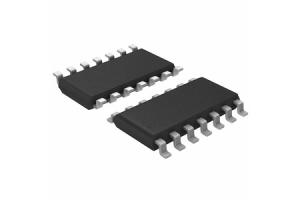
ATTINY20 8-bit AVR Microcontroller: Datasheet, Alternatives, and Pinout
on November 17th
Popular Posts
-

What is GND in the circuit?
on January 1th 3328
-

RJ-45 Connector Guide: RJ-45 Connector Color Codes, Wiring Schemes, R-J45 Applications, RJ-45 Datasheets
on January 1th 2854
-

Understanding Power Supply Voltages in Electronics VCC, VDD, VEE, VSS, and GND
on November 21th 2793
-

Fiber Connector Types: SC Vs LC And LC Vs MTP
on January 1th 2284
-

Comparison Between DB9 and RS232
on January 1th 1902
-

What Is An LR44 Battery?
Electricity, that ubiquitous force, quietly permeates every aspect of our daily lives, from trivial gadgets to life-threatening medical equipment, it plays a silent role. However, truly grasping this energy, especially how to store and efficiently output it, is no easy task. It is against this background that this article will focus on a type of coin cell battery that may seem insignificant on the...on January 1th 1860
-

What Is RF and Why Do We Use It?
Radio Frequency (RF) technology is a key part of modern wireless communication, enabling data transmission over long distances without physical connections. This article delves into the basics of RF, explaining how electromagnetic radiation (EMR) makes RF communication possible. We will explore the principles of EMR, the creation and control of RF signals, and their wide-ranging uses. The article ...on January 1th 1845
-

Understanding the Fundamentals:Inductance Resistance, andCapacitance
In the intricate dance of electrical engineering, a trio of fundamental elements takes center stage: inductance, resistance, and capacitance. Each bears unique traits that dictate the dynamic rhythms of electronic circuits. Here, we embark on a journey to decipher the complexities of these components, to uncover their distinct roles and practical uses within the vast electrical orchestra. Inductan...on January 1th 1831
-

Comprehensive guide to hFE in transistors
Transistors are crucial components in modern electronic devices, enabling signal amplification and control. This article delves into the knowledge surrounding hFE, including how to select a transistor's hFE value, how to find hFE, and the gain of different types of transistors. Through our exploration of hFE, we gain a deeper understanding of how transistors work and their role in electronic circu...on November 21th 1828
-

CR2430 Battery Comprehensive Guide: Specifications, Applications and Comparison to CR2032 Batteries
What is CR2430 battery ?Benefits of CR2430 BatteriesNormCR2430 Battery ApplicationsCR2430 EquivalentCR2430 VS CR2032Battery CR2430 SizeWhat to look for when buying the CR2430 and equivalentsData Sheet PDFFrequently Asked Questions Batteries are the heart of small electronic devices. Among the many types available, coin cells play a crucial role, commonly found in calculators, remote controls, and ...on January 1th 1827















